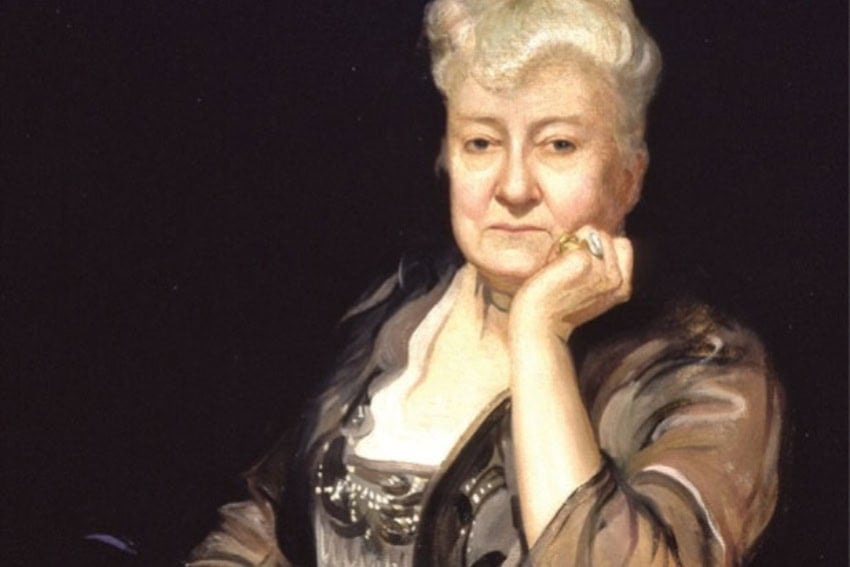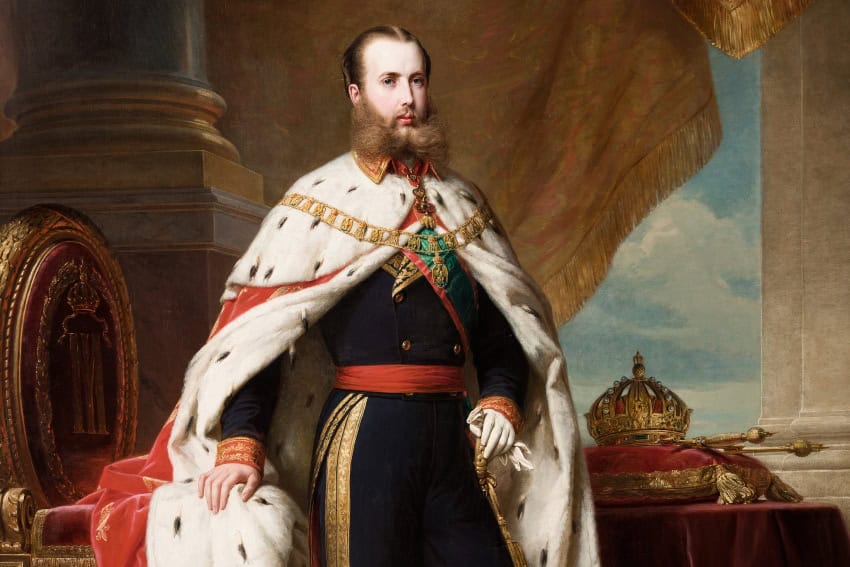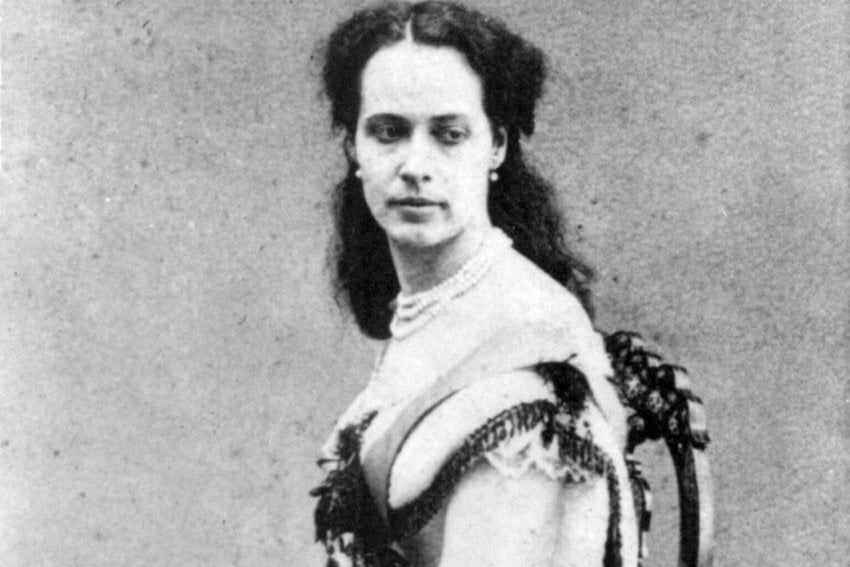Sara Yorke Stevenson would be many things during her life. Author, suffragette, journalist, museum curator, and most famously, a distinguished Egyptologist. From 1862 to 1867, she lived in Mexico City, where she witnessed both the arrival of Emperor Maximilian and the departure of French troops, the latter marking the end of French dreams for a Mexican Empire. While her book, “Maximilian in Mexico: A Woman’s Reminiscences of the French Intervention 1862-1867,” contributes little to the well-documented political history of these turbulent times, her account contains numerous unique and fascinating insights into life in Mexico City. C. M. Mayo credited her as writing “the most lucid, informed, and balanced … of all the English-language memoirs of the Second Empire/French Intervention,” and she would feature Sara and her mother in her successful novel, “The Last Prince of the American Empire.”
Sara came from a wealthy family that had investments in the southern U.S. cotton industry. In the early 1840s, her parents moved to Paris, and Sara was born there in 1847. When her parents relocated back to the U.S., ten-year-old Sara stayed in France, where she attended boarding school. She was placed under the guardianship of M. Achille Jubinal and his wife, from whom she gained her interest in antiques and archaeology. In 1862, her parents moved once again, this time settling in Mexico City. When her brother was killed by bandits, they decided it was time to reunite the family, and Sara was instructed to pack her bags and head for Mexico.

The Second French Intervention in Mexico
The previous year, France had landed a military force at Veracruz, in a heavy-handed attempt to force the new Liberal government into paying its outstanding foreign debts. There was great excitement in France at this event, believing they were witnessing the start of a golden period during which French expertise would open mines, expand the telegraph service and build railroads. This would all be to the benefit of the Mexicans and to the profit of Paris. Indeed, Sara’s journey to Mexico would be on the maiden voyage of a new steamship service, the first to directly link France with Mexico. Sara was a little chilled to find that two of the young passengers were surgeons, sent out to increase the staff at the military hospital. This was the first indication that the Mexican adventure was coming at a cost.
After stops in Cuba and Martinique, Sara had her first glimpse of Mexico on May 2, 1862. “A dark, broadening line upon the horizon, behind which soon loomed up in solitary dignity the snow-capped peak of Orizaba.” Like most visitors to Veracruz, she commented on the heat and the vultures. These large, black birds were the town’s only refuse collectors, and as such were protected. This had allowed their numbers to increase to the point where they covered the flat roofs and steeples of the town. While they waited for permission from the health officer to land, passengers received news that the military force of General Charles de Lorencez had been forced back at Puebla.
Her arrival in Mexico City
The defeat of a European army was a shock, and it meant that the road to Mexico City was now closed to foreigners. Travelers would have to risk the longer and bandit-infested route via Xalapa. This required employing an escort of bandits who, having taken the travelers into their care, could negotiate safe passage with any other ruffians the party might encounter. Sara and a small group of fellow travelers found a bandit captain recommended by friends, a man whose credentials included an impressive saber scar on his face.
Their guide proved trustworthy, and after nine days they reached the crest of a mountain, from which they looked down on the valley of Mexico and the capital. Sara described the view: “With its two hundred thousand souls, its picturesque buildings, and the lakes of Chalco and Tezcuco, while to one side the huge snow-capped volcanoes, the Iztaccihuatl and the Popocatépetl, like two gigantic sentries, seemed to watch over the sacredness of this classical spot of Mexican history.”
After the excitement of the journey, Mexico City seemed quite peaceful, and the new arrivals were wined and dined by the small expatriate community. Many upper-class Mexicans mixed freely with the foreigners, and Sara noted the happy mood of the Liberal supporters, as if victory at Puebla had ended the danger of French intervention. “Society danced and flirted, rode in the Paseo, and walked in the Alameda,” she later recalled. There were amateur bullfights in the Plaza de Toros, where rich young aristocrats put on a show with far more heraldry than the rather grabby professional circuses of the time.
There was also a dark side to Mexico in 1862. Bands of outlaws roamed the countryside, and the stage coaches that linked the capital with the provinces were regularly robbed. Neither was the city itself safe from violence. “No man, in those days, ventured out of an evening to pay a call without being well armed.” The secretary of the Prussian legation, a man who apparently had the knack of making enemies, had been badly injured in one attack. Kidnapping was common and particularly feared, the mistreatment of victims being legendary.
The French army takes Mexico City

As Sara settled into her new home, the French government set about avenging the defeat at Puebla, with the advance guard of General Forey’s army entering the capital on June 10, 1863. That morning, Sara went onto the balcony to see the unexpected sight of a group of senior officers in the street below. “As we appeared at the balcony, there was a perceptible flutter among them, and some of them began to ogle us as only Frenchmen could, whose eyes had not rested upon a white woman for several months.” The French administration returned the Conservatives to power, a move that pleased many people. Short of money, the Liberal government had been exhorting the rich for loans and seizing boys from the slums for the army ranks. After years of civil war, the French intervention seemed to promise stability and peace.
Sarah was aware that problems remained, noting that while the liberal forces might have been forced from Mexico City, they had not been defeated, and the countryside remained as lawless as ever. Stage coaches were regularly attacked, and in an incident that shocked the community, highwaymen tore up the rails of the Paso del Macho Railroad and kidnapped several of the passengers for ransom. When young officers offered to take Sara and her friends on a picnic by the ruins of an old Spanish aqueduct, it was deemed wise to take an additional guard of soldiers, this just 20 kilometers from the city.
Emperor Maximilian’s Mexico
Under French “guidance,” the new Conservative government accepted an Austrian archduke, Ferdinand Maximilian, as Emperor of the Second Mexican Empire. Sara witnessed the royal couple’s arrival in the city, a parade not equaled since the days of the Mexica. “Triumphal arches of verdure, draped with flags and patriotic devices, were raised along the principal avenues leading to the Plaza Mayor and to the palace. As far as the eye could reach, the festively decked windows, the streets, and the flat roofs of the houses were crowded with people eager to catch a glimpse of the new sovereigns.”
It was an optimistic time for some. The royal court glittered, trade boomed, customs duties increased, and loans were given freely. An Anglo-French company won the concession to build a railway linking Veracruz to Mexico City, a project they promised would be completed in five years. With the center of the country subdued by the French army, the Emperor started a tour of the provinces. Sara, however, was becoming less optimistic about the future. The abundance of money, she wrote, “dazzled the people, and a golden dust was thrown into the eyes of all, which for a brief period prevented them from seeing the true drift of political events.” Indeed, despite the young emperors’ good intentions, the imperial experiment would be short-lived and would end in bloodshed and disaster.
Final glimpses
By 1866, the French government was losing its appetite for a war that had dragged on for nearly five years. While not unexpected, the announcement in December that the French army would be called home sent shock waves through the foreign community. “One heard of little else than of the safest and most comfortable way of getting down to the coast,” Sara wrote. The Stevenson family was one of the first to leave, and Sara’s last night in Mexico City was spent taking supper at a friend’s house. Then, at 3 a.m., the family was escorted to the stagecoach. “The gloom of that early start in the darkness of the morning! The dreariness of everyone’s attempt at cheerfulness! And then the approaching noise of the mules.”
At least with the French army in retreat, the road was safer than usual, and after the first day of hard traveling, the stagecoach rested in the safety of a military camp. Here, Sara caught a glimpse of one of the great characters of this adventure, Princess Salm-Salm, “in her gray-and-silver uniform, sitting her horse like a female centaur — truly a picturesque figure, with her white couvre-nuque glistening under the tropical sun.” In Veracruz, it was life as normal, and Sara and her family were invited to breakfast by the commander and entertained on board the flagship of Admiral Cloue. All talk now was of the Emperor and whether, as everybody expected, he too would shortly flee the country.

From Mexico to Egyptology
And so the Stevenson family returned to the United States. Most of their money had been invested in Mexico, and her father, who was already ill, never recovered from the loss. He died soon afterwards. Sara, still only twenty, made a living as a music and dance teacher, married an attorney, and entered into Philadelphia’s social life. Building on the love of archaeology she had first acquired in Paris, she enjoyed a distinguished career as an Egyptologist. She would become the first woman to lecture at the Peabody Museum and the first woman to receive an honorary degree from the University of Pennsylvania. Her account of the Second Mexican Empire, “Maximilian in Mexico: A Woman’s Reminiscences of the French Intervention 1862-1867,” was published in 1899.
Bob Pateman is a Mexico-based historian, librarian and a life-term hasher. He is editor of On On Magazine, the international history magazine of hashing.
